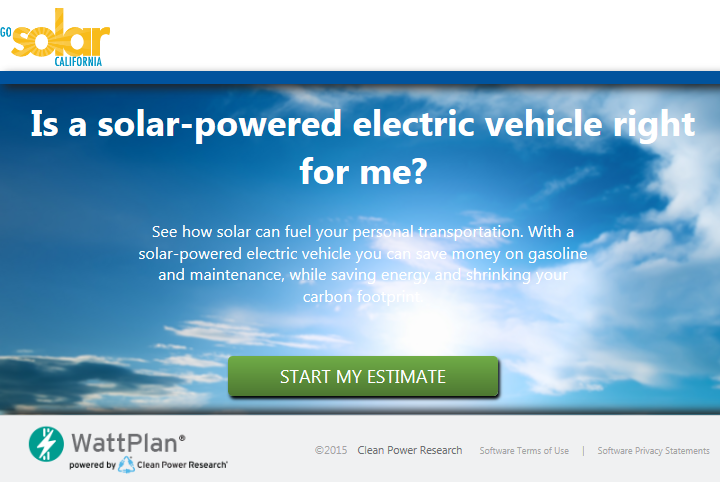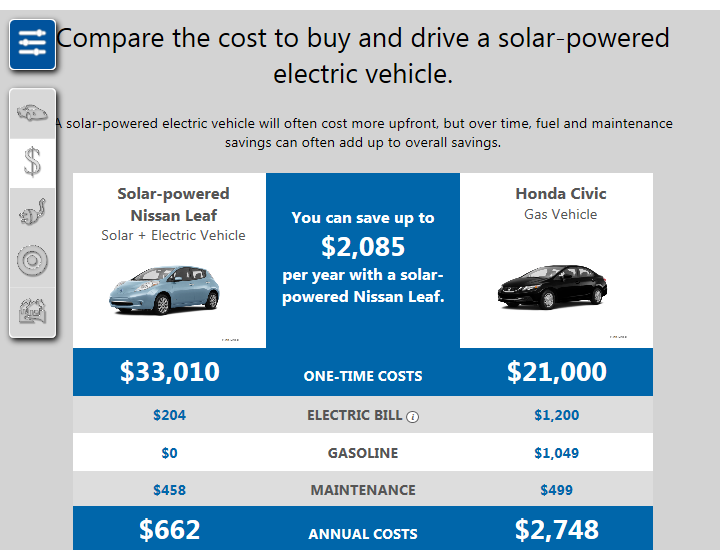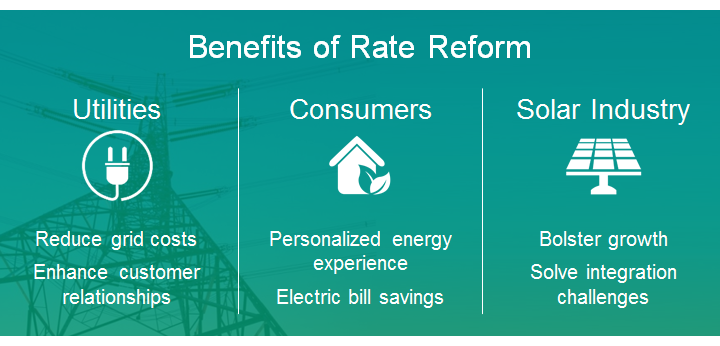Utilities nationwide are adding variety to residential electric rate plans and reconsidering how to value rooftop solar. Rate changes being considered include demand charges and net metering “2.0” policies that provide customers less than full retail credit. These changes have many questioning whether rooftop solar can continue its tremendous growth.
While solar alone may be less attractive under these circumstances, rate reform offers an amazing opportunity to bolster solar industry growth, and benefit both utilities and energy consumers. The key is combining solar with distributed energy resource (DER)1 offerings such as energy storage, plug-in electric vehicles and/or demand response. By leveraging well designed rates, the Rocky Mountain Institute (RMI) estimates that utilities can reduce grid costs by 10-15%, and consumers will have the freedom to personalize their energy experience and save on their electricity bills.
One fundamental requirement to unlocking these opportunities will be transparency. With tools like WattPlan®, it’s now possible to quickly provide objective information on the bill impacts of switching rates, purchasing an electric vehicle, or installing solar or a smart thermostat. With this information, the solar industry, utilities and energy consumers alike can tap into the immense opportunities offered by well-designed rates.

The California Solar Initiative offers WattPlan to customers in California for evaluating solar plus an electric vehicle
Driving solar industry growth
New demand charge rates and net-metering policies provide the rooftop solar industry a huge opportunity to spur growth by bundling solar with other DERs. Solar combined with other technologies such as smart thermostats, demand control devices or energy storage makes it possible to shift flexible loads such as air conditioning, electric space heating or electric water heating. In this way, energy consumers can avoid demand charges, or align usage with solar production during midday to avoid exporting electricity when prices are low.
Furthermore, demand charges are typically paired with cheap energy rates, which makes combining solar with fuel-switching DERs such as electric vehicles or electric heat pump water heaters extremely attractive. The RMI report found that total savings of 10-40% can be achieved with a blended DER approach as compared to solar alone.
Promoting a combination of technologies also helps solve grid integration issues that could impact grid reliability for higher DER penetration. Alleviating growing peak demand and steep ramp rates in pursuit of a more manageable load curve is critical to the long-term success of solar.
Potential for the utility
By offering rate options that allow consumers to respond to time-varying pricing and separate charges for peak demand and energy, utilities can:
- Lower capacity investments such as building new power plants or transmission infrastructure upgrades.
- Reduce grid line losses by reducing transmission line congestion.
- Avoid using high-cost reserve power during peak periods.
- Mitigate renewable energy integration challenges.
The RMI estimates potential savings to be $9 billion per year in U.S. grid investment costs—more than 10% of total forecasted needs—and $4 billion per year in annual energy production and ancillary service needs.
Rate reform also offers utilities a chance to engage customers. Utilities that take it upon themselves to educate customers on rate options and DER technologies will become instrumental contributors in the DER acquisition process.
Choice and savings for the consumer
In today’s “à la carte” society, consumers are looking for personalized, mix-and-match options. Hulu and Netflix, as well as Uber, Airbnb, Zipcar and car2go are examples of disruptive innovations that are giving consumers more choice and convenience.
Solar and smart thermostats have been the poster child of this trend for the energy industry, but new technologies such as electric vehicles and energy storage are gaining momentum. As a result, the menu of options on the energy technology buffet is only growing.
With the introduction of varied rate options, the consumer can now mix-and-match energy technologies with the rate plan that’s right for them to gain a completely personalized energy experience. The result: improved comfort and convenience with bill savings along the way.
Fueling rate reform transparency
Having uncovered the strong overlap of consumer interest between solar and electric vehicles, The California Solar Initiative (CSI) is already educating consumers on combining DERs. Using WattPlan, California residents that already have solar, or are interested in going solar, can receive a personalized assessment of the potential savings from combining solar and electric vehicles.

Example WattPlan analysis comparing the costs of solar-powered electric and gas vehicles
A critical component of this estimate is electric rate comparison. WattPlan provides a personalized rate recommendation based on individual electricity use patterns (obtained from Green Button data), unique electric vehicle charging characteristics and rooftop-specific solar system production. Energy consumers can also compare rates side-by-side to understand how their bill would be affected for each rate plan option.
Seizing the opportunities
While the sea of new and impending rate plans and policy changes present initial challenges to utilities, the solar industry and consumers alike, there is also significant benefit to be had by all.

The degree to which the benefits offered by well-designed rates are realized, however, will be critically dependent on a number of factors:
- Thoughtful rate reform that accurately communicates utility costs to consumers.
- The development of business models that combine DER technologies.
- Transparent consumer education.
The opportunities offered by rate reform are real, and the tools and technologies to take advantage of them are here today.
1 Distributed Energy Resource: resources on the customer or “distribution” side of the electrical system, such as rooftop solar, energy storage, plug-in electric vehicles and demand response (Draft Final Proposal: Expanded Metering and Telemetry Options Phase 2 – Distributed Energy Resource Provider), California ISO, June 2015.
